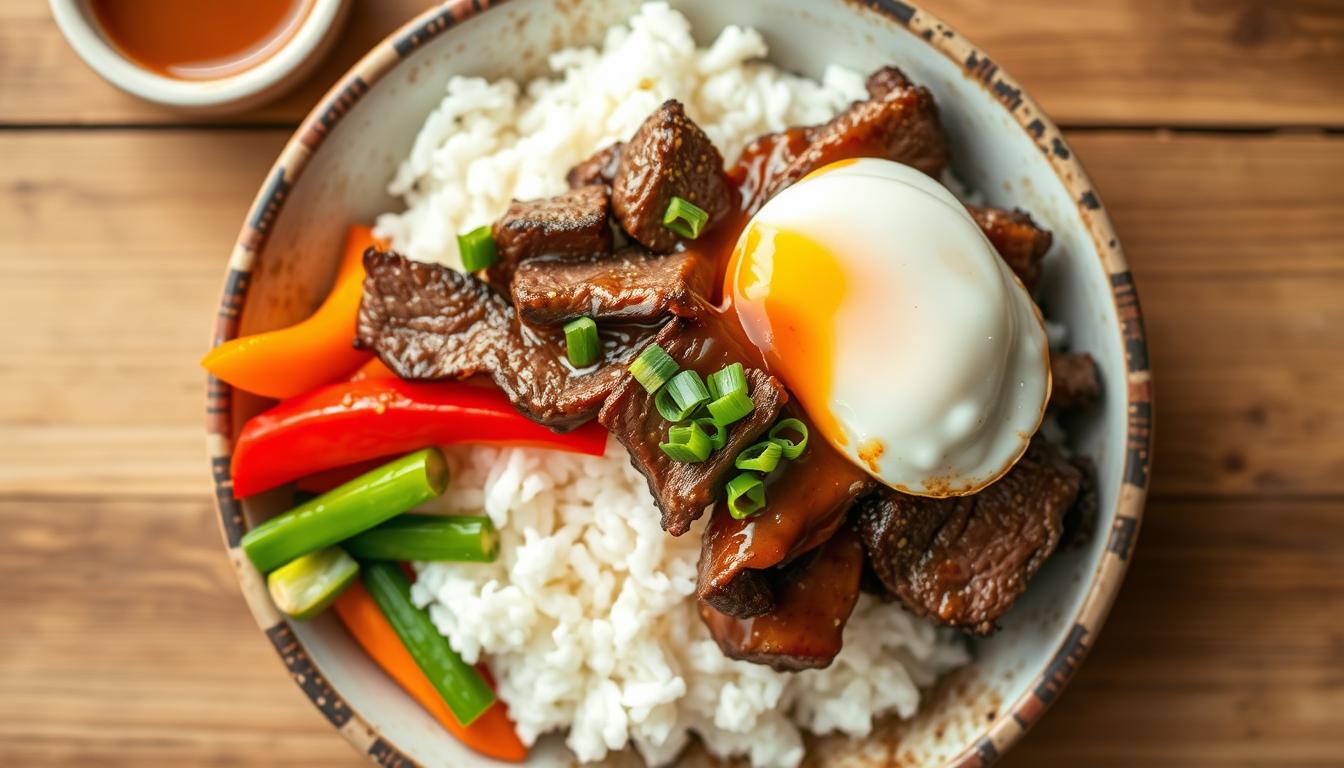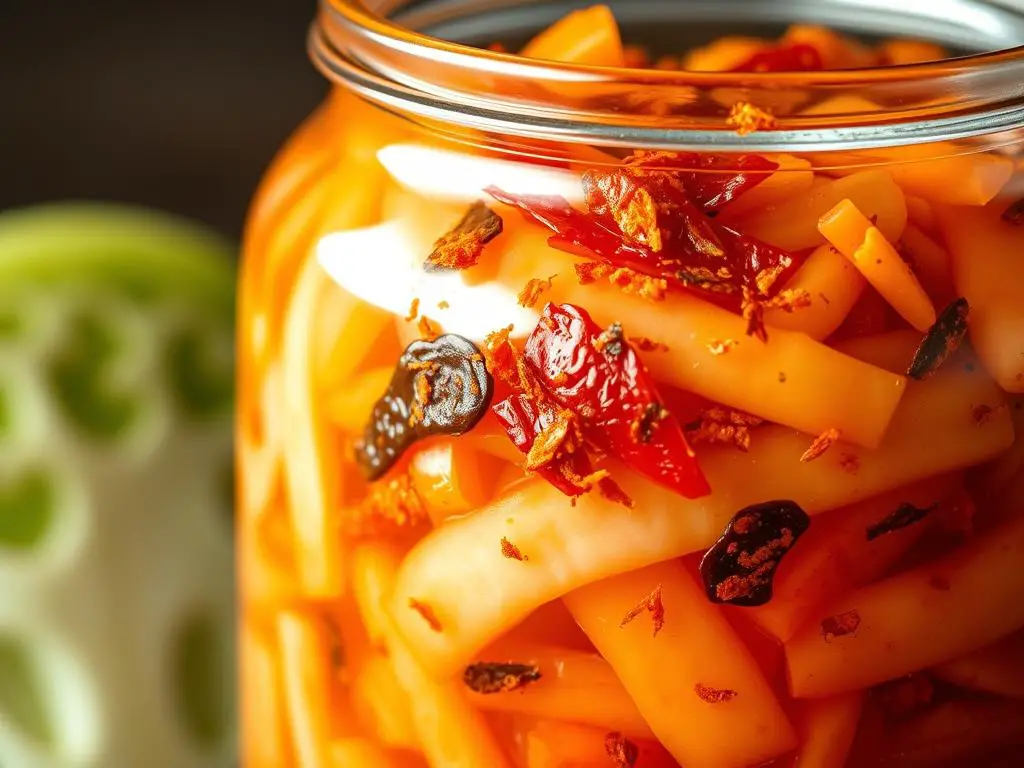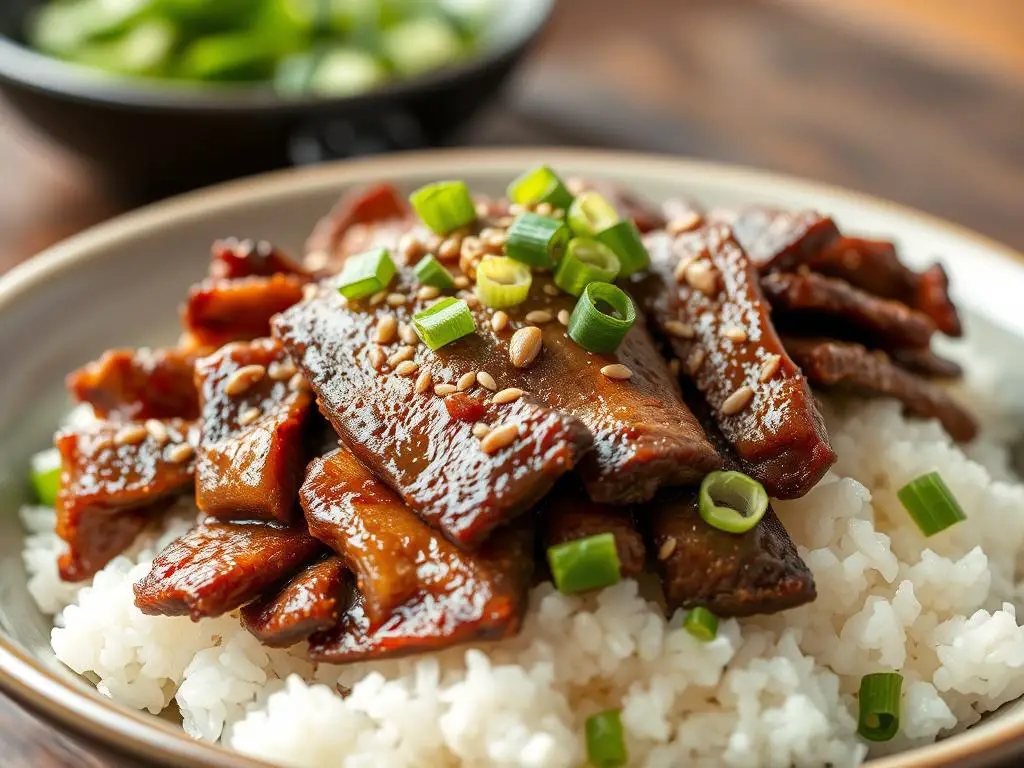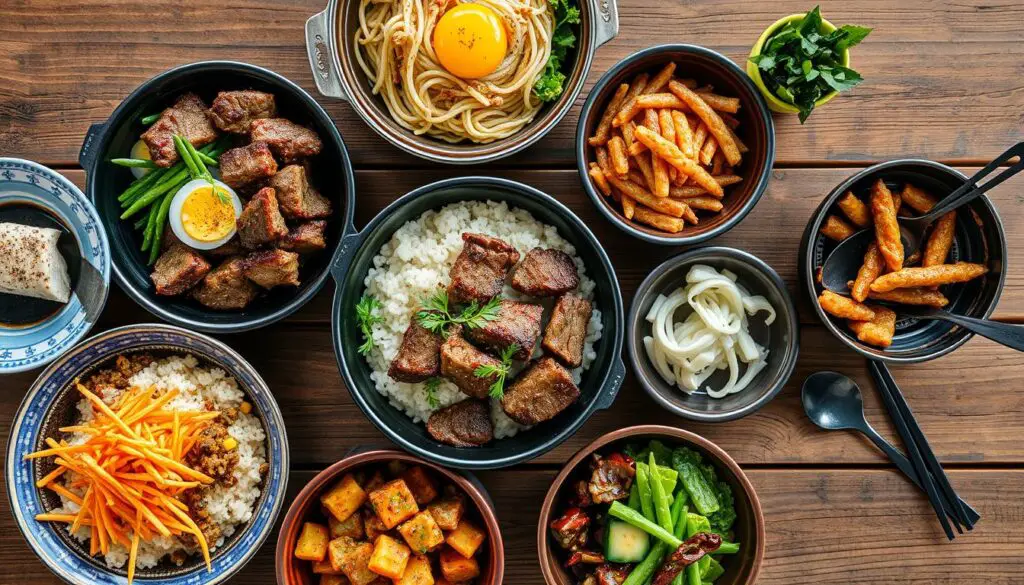Whether you're new to Korean cuisine or a seasoned enthusiast, this recipe delivers an explosion of flavors that will transport your taste buds straight to Seoul. The best part? It's surprisingly simple to make at home!
What Makes Korean BBQ Rice Bowls So Special?
What sets Korean BBQ apart is the unique marinade that infuses the meat with complex flavors. Traditional Korean marinades feature a blend of soy sauce, brown sugar, sesame oil, garlic, and ginger, often with the addition of fruit (like Asian pear) to tenderize the meat.
When this marinated meat is cooked at high heat, it develops a beautiful caramelization that's packed with umami goodness.Our BBQ Korean Steak Rice Bowl recipe brings all these elements together in one harmonious dish that's perfect for weeknight dinners or weekend entertaining. Let's dive into what you'll need to create this flavor explosion at home!
Ingredients You'll Need

The beauty of this BBQ Korean Steak Rice Bowl lies in its balance of flavors and textures. Here's everything you'll need to create this delicious meal:
For the Korean BBQ Steak Marinade:
- 1 pound top sirloin steak, thinly sliced against the grain
- 1/3 cup soy sauce (low sodium recommended)
- 3 tablespoons brown sugar
- 2 tablespoons sesame oil
- 1 tablespoon gochujang (Korean chili paste)
- 4 cloves garlic, minced
- 1 tablespoon fresh ginger, grated
- 1/2 Asian pear, grated (or substitute with a regular pear or apple)
- 2 tablespoons green onions, chopped
For the Rice Bowl:
- 2 cups cooked white rice (short-grain preferred)
- 1 cup spinach or mixed greens
- 1 carrot, julienned or spiralized
- 1 bell pepper (red or yellow), thinly sliced
- 1/2 cucumber, thinly sliced
- 2 green onions, sliced diagonally
- 4 eggs (optional, for topping)
- Kimchi for serving (optional)
For the Sauce:
- 2 tablespoons gochujang
- 1 tablespoon honey or maple syrup
- 1 tablespoon sesame oil
- 1 tablespoon rice vinegar
- 1 tablespoon water (to thin)
- 1 teaspoon sesame seeds
Essential Korean Ingredients
New to Korean cooking? These authentic ingredients will elevate your BBQ Korean Steak Rice Bowl:
Preparation: Marinating the Perfect Korean BBQ Steak

The key to authentic BBQ Korean Steak Rice Bowls lies in the marinade and proper preparation of the meat. Follow these steps for the best results:
Step 1: Prepare the Steak
- Slice the steak properly: Place your sirloin steak in the freezer for about 30 minutes to firm it up. This makes it much easier to slice thinly. Once chilled, slice the steak against the grain into very thin strips, about 1/8-inch thick.
- Place the sliced steak in a large bowl or resealable plastic bag for marinating.
Step 2: Make the Marinade
- In a food processor, combine the garlic, ginger, and Asian pear (or substitute). Pulse until a smooth paste forms.
- Transfer the paste to a bowl and add the soy sauce, brown sugar, sesame oil, gochujang, and chopped green onions.
- Whisk all ingredients together until the sugar is dissolved and the marinade is well combined.
Step 3: Marinate the Steak
- Pour the marinade over the sliced steak, making sure all pieces are well coated.
- Cover or seal and refrigerate for at least 1 hour, preferably 4 hours, or overnight for maximum flavor.
Pro Tip: For the most tender results, don't skip the Asian pear in your marinade! The enzymes in the pear help break down the proteins in the meat, resulting in incredibly tender steak. If you can't find Asian pear, a regular pear or apple will work as a substitute.
Cooking Your BBQ Korean Steak to Perfection
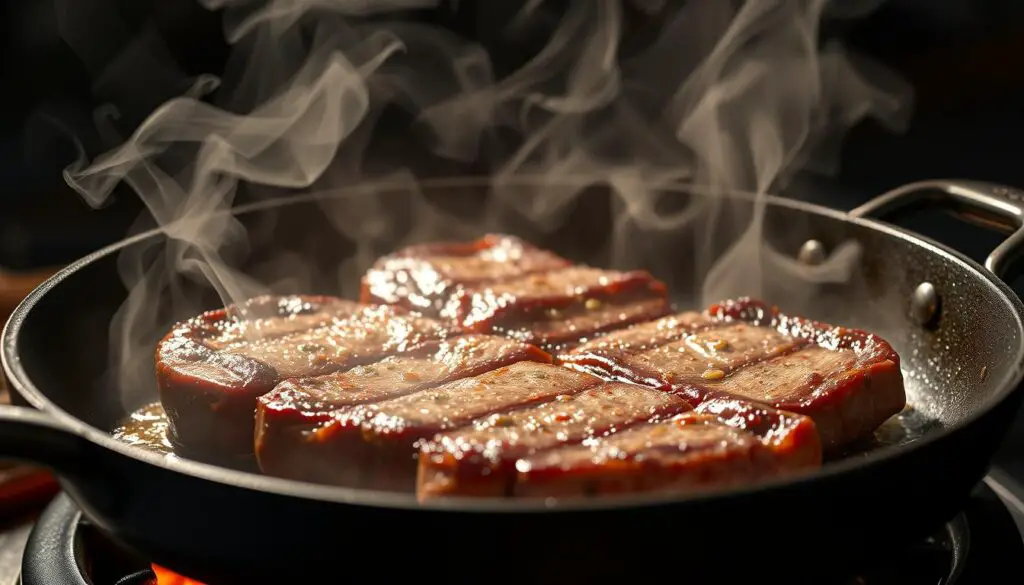
The secret to authentic Korean BBQ flavor is cooking the meat quickly over high heat to achieve that perfect caramelization while keeping the inside tender and juicy. Here's how to cook your marinated steak:
Step 1: Prepare Your Pan
- Heat a large heavy-bottomed skillet or cast-iron pan over high heat until it's very hot. The pan should be smoking slightly.
- Add 1 tablespoon of neutral oil with a high smoke point (like vegetable or grapeseed oil).
Step 2: Cook the Steak
- Remove the steak from the marinade, allowing excess marinade to drip off. (Reserve the marinade if you want to make a sauce.)
- Working in small batches to avoid overcrowding the pan, add the marinated steak strips in a single layer.
- Cook for 1-2 minutes without disturbing to get a good sear, then flip and cook for another 30 seconds to 1 minute.
- Remove the cooked steak to a plate and continue with remaining batches.
Why cook in batches? Overcrowding the pan will cause the meat to steam rather than sear. For that authentic Korean BBQ caramelization, make sure your steak has room to sizzle!
Step 3: Make the Sauce
- In a small bowl, whisk together the gochujang, honey, sesame oil, rice vinegar, water, and sesame seeds.
- Adjust the consistency by adding more water if needed. The sauce should be thick but pourable.
Essential Cookware for Perfect Korean BBQ
Get restaurant-quality results with the right tools:
Assembling Your BBQ Korean Steak Rice Bowl
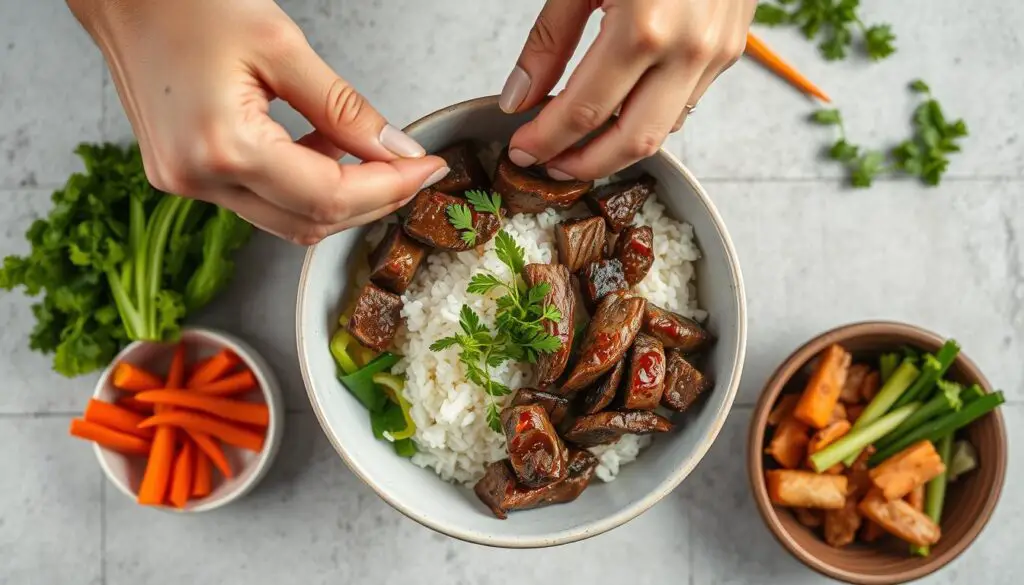
Now comes the fun part – assembling your beautiful and delicious BBQ Korean Steak Rice Bowl! The key is to create a visually appealing arrangement that also allows you to enjoy all the flavors together.
Step 1: Prepare the Base
- Divide the cooked rice among 4 serving bowls, placing it in the center or on one side.
- Arrange a portion of the mixed greens or spinach alongside or on top of the rice.
Step 2: Add the Vegetables
- Arrange the julienned carrots, sliced bell peppers, cucumber, and any other vegetables in separate sections around the bowl.
- If using kimchi, add a small portion to the bowl.
Step 3: Add the Star Ingredient
- Place a generous portion of the cooked Korean BBQ steak on top of or next to the rice.
- Sprinkle with sliced green onions and additional sesame seeds.
Step 4: The Perfect Finishing Touches
- If using eggs, you can either place a fried egg on top or add a soft-boiled egg cut in half.
- Drizzle the gochujang sauce over the bowl or serve it on the side for dipping.
“The beauty of Korean rice bowls is in their balance – each component brings its own flavor and texture, creating a harmonious meal that's greater than the sum of its parts.”
Delicious Variations for Your BBQ Korean Steak Rice Bowl
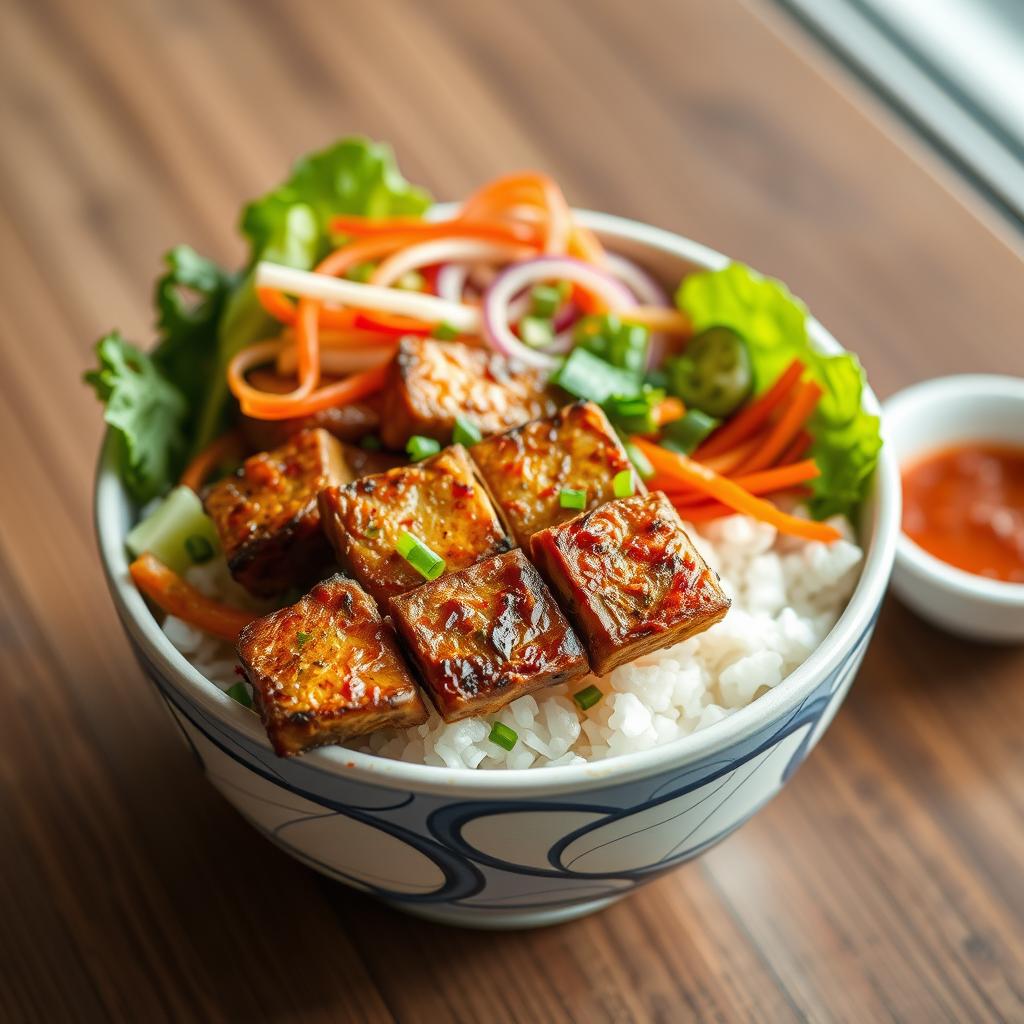
Vegetarian/Vegan Option
Replace the steak with extra-firm tofu or tempeh. Press the tofu to remove excess moisture, then slice and marinate using the same Korean BBQ marinade. For a vegan version, replace honey with maple syrup in the sauce.
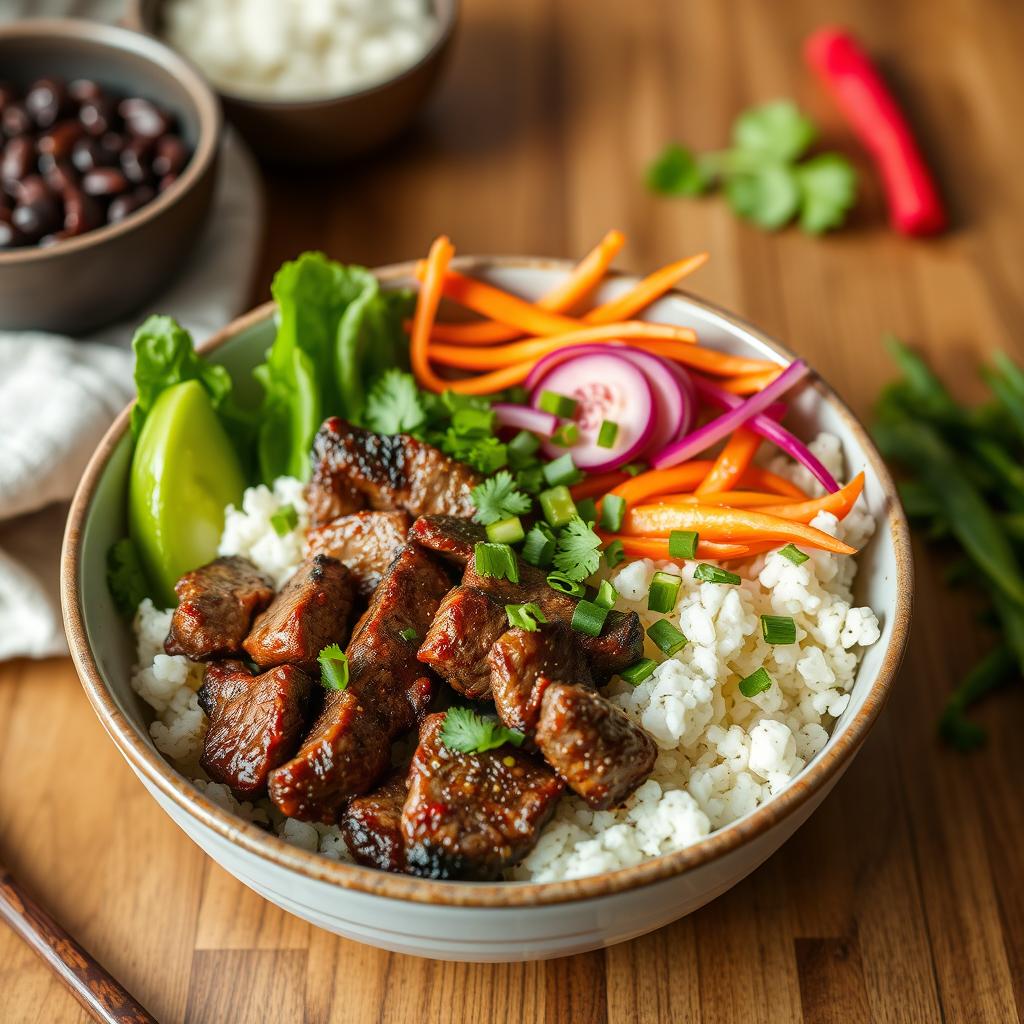
Low-Carb Option
Substitute white rice with cauliflower rice for a lower-carb alternative. Simply pulse cauliflower florets in a food processor until they resemble rice grains, then sauté for 5-7 minutes until tender.

Extra Spicy Version
Double the amount of gochujang in both the marinade and sauce, and add sliced fresh chilies as a topping for those who love heat. You can also add a drizzle of chili oil for an extra kick.
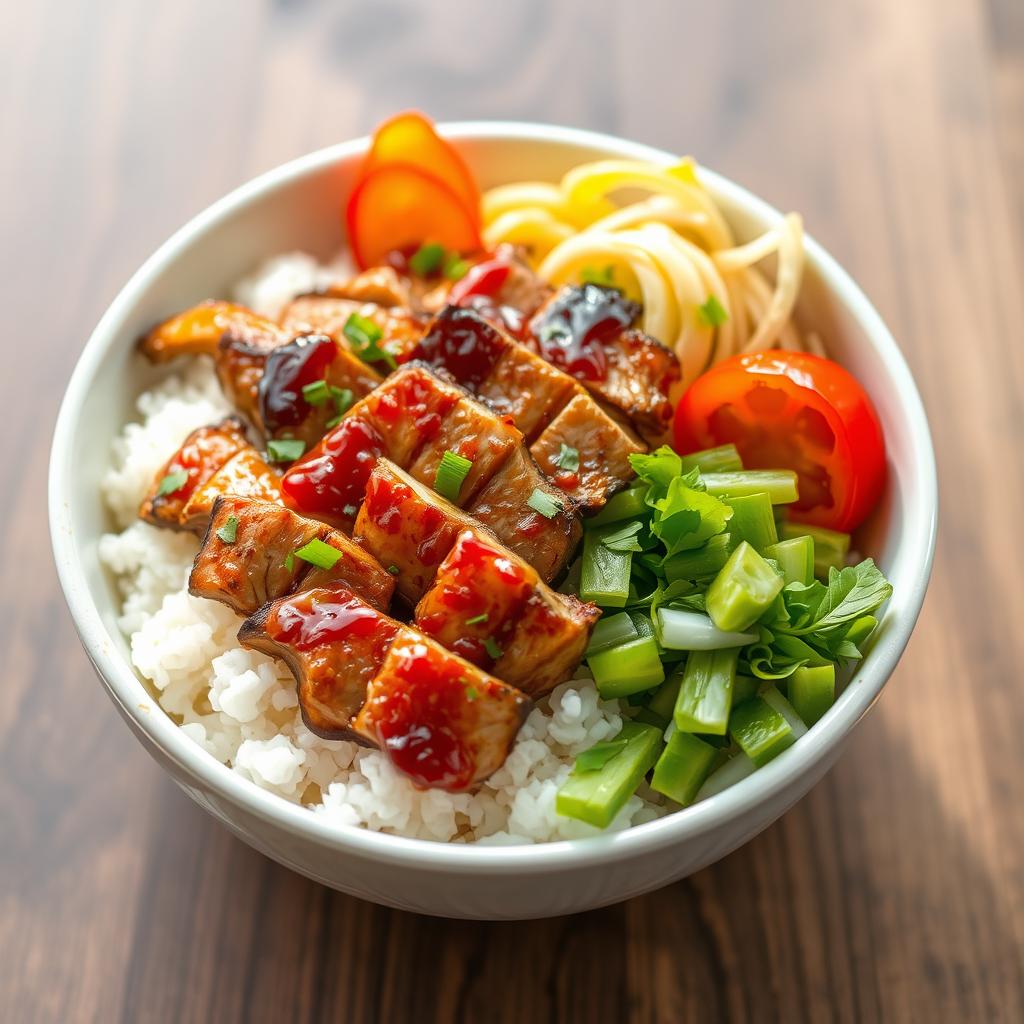
Chicken or Pork Alternative
Substitute the steak with thinly sliced chicken thighs or pork tenderloin. The marinade works beautifully with these proteins as well, though you may want to adjust cooking times accordingly.
Serving and Presentation Tips

Elevate your BBQ Korean Steak Rice Bowl with these presentation tips that will make your meal look as good as it tastes:
Bowl Selection
Traditional Korean meals are often served in stone bowls called “dolsot,” which keep the food hot throughout the meal. If you don't have stone bowls, wide, shallow ceramic bowls work beautifully and showcase all the colorful components.
Artistic Arrangement
Korean food emphasizes visual appeal through color and arrangement. Try these techniques:
- Arrange ingredients in a circular pattern around the rice for a traditional bibimbap presentation
- Group ingredients by color for a rainbow effect
- Place the egg on top as the centerpiece
- Drizzle the sauce in an artistic pattern rather than mixing it in
Garnishes That Pop
The final touches can make your bowl truly Instagram-worthy:
- Sprinkle with toasted sesame seeds for texture and visual appeal
- Add thinly sliced green onions cut on a diagonal
- Include a small bundle of microgreens for height and freshness
- Serve with additional sauce on the side in a small dipping bowl
Authentic Korean Tableware
Elevate your Korean dining experience with traditional bowls:
Nutritional Highlights of BBQ Korean Steak Rice Bowls
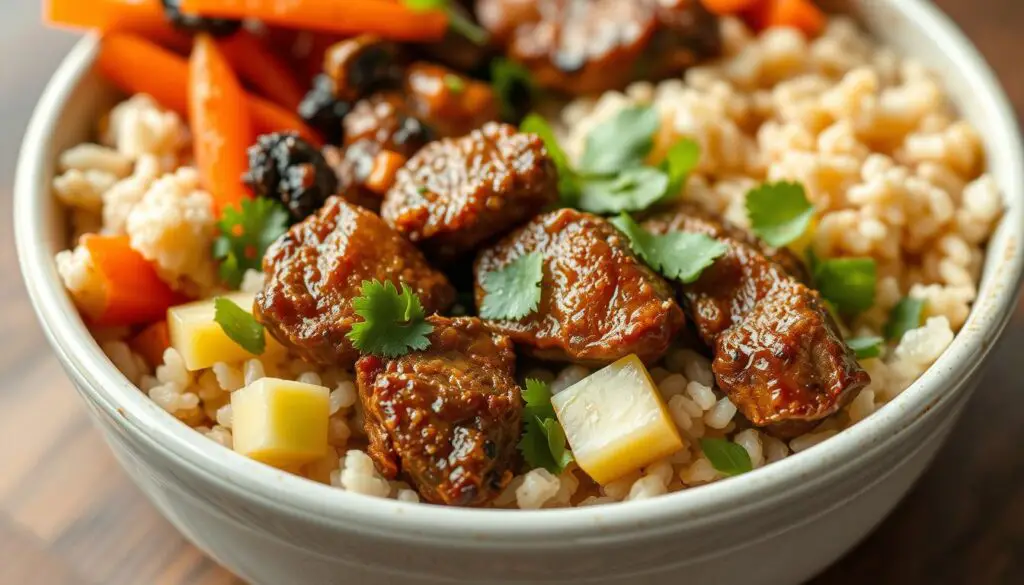
Beyond being delicious, BBQ Korean Steak Rice Bowls offer a well-balanced meal packed with nutrients. Here's what makes this dish a nutritional powerhouse:
Protein-Rich
The sirloin steak provides high-quality protein essential for muscle maintenance and growth. A typical serving offers approximately 25-30g of protein, helping you feel satisfied longer.
Balanced Macronutrients
With a good balance of protein from the steak, complex carbohydrates from the rice, and healthy fats from the sesame oil, this meal provides sustained energy without blood sugar spikes.
Vegetable Variety
The colorful array of vegetables contributes essential vitamins, minerals, and fiber. The different colors represent various phytonutrients that support overall health and immune function.
Probiotic Benefits
If you include kimchi as a topping, you'll get the added benefit of probiotics that support gut health and digestion. Fermented foods like kimchi have been linked to improved immune function and overall wellness.
A typical serving of this BBQ Korean Steak Rice Bowl contains approximately 450-550 calories, making it a satisfying yet reasonable meal for most dietary needs. The balance of nutrients also makes it an excellent post-workout meal, providing the protein needed for muscle recovery and carbohydrates to replenish glycogen stores.
Make-Ahead and Storage Tips
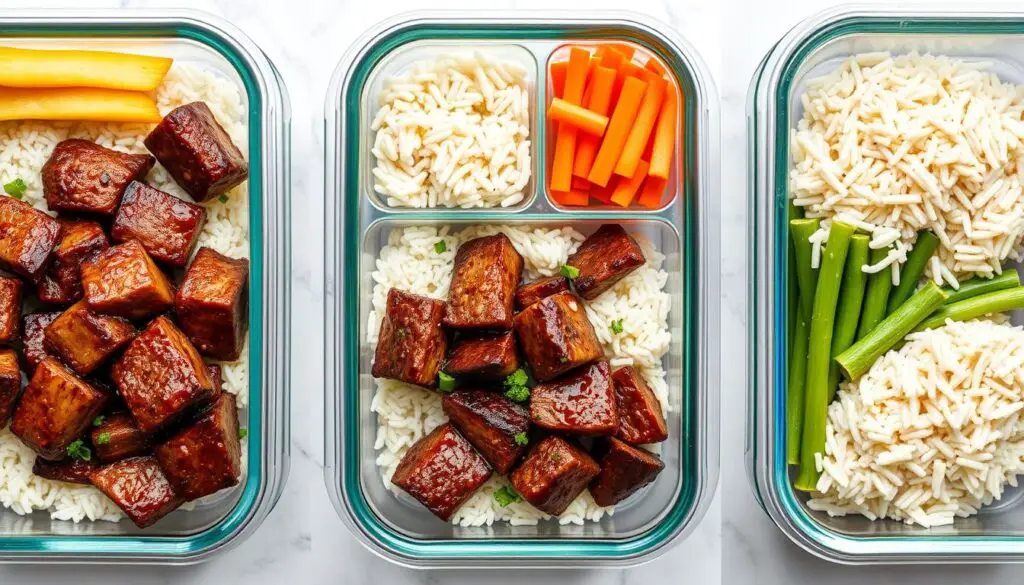
BBQ Korean Steak Rice Bowls are perfect for meal prep and can be prepared in advance for busy weekdays. Here's how to make the most of your preparation:
Marinating in Advance
The steak can be marinated for up to 24 hours in advance, which not only saves time but actually improves the flavor and tenderness. Simply prepare the marinade, combine with the sliced steak, and refrigerate in an airtight container until ready to cook.
Component Preparation
For the best meal prep experience, prepare and store components separately:
- Cook the rice and store in an airtight container for up to 3 days
- Slice and prepare vegetables up to 2 days in advance
- Cook the steak and store separately for up to 3 days
- Make the sauce and store in a small container for up to 1 week
Assembly and Reheating
When ready to enjoy:
- Reheat the rice with a sprinkle of water to prevent drying out
- Warm the steak gently in a pan or microwave
- Assemble with fresh vegetables and sauce
- If using an egg, cook it fresh just before serving
Food Safety Tip: Always refrigerate marinated meat and prepared components promptly. When reheating, ensure the steak reaches an internal temperature of 165°F (74°C) for food safety.
Frequently Asked Questions
What cut of beef works best for Korean BBQ?
Top sirloin is ideal for BBQ Korean Steak Rice Bowls because it offers a good balance of tenderness and flavor at a reasonable price point. Other excellent options include ribeye (for more marbling and richness), flank steak, or skirt steak (both of which have great flavor but should be sliced very thinly against the grain). In authentic Korean BBQ, cuts like bulgogi (thinly sliced ribeye or sirloin) or galbi (short ribs) are commonly used.
Can I make this recipe without gochujang?
While gochujang provides the authentic Korean flavor profile, you can substitute with a mixture of 1 tablespoon sriracha, 1 teaspoon miso paste, and 1 teaspoon honey or brown sugar for each tablespoon of gochujang. This won't be exactly the same, but will provide a similar sweet-spicy-umami flavor. For a non-spicy version, you can omit the gochujang and add a bit more soy sauce and brown sugar.
What's the best type of rice to use?
Short-grain white rice is traditional for Korean dishes, as it's slightly sticky and holds together well. Medium-grain rice like Calrose is also an excellent option. For a healthier alternative, you can use brown rice or cauliflower rice. Just note that the texture will be different from the traditional version.
How spicy is this dish?
As written, this recipe has a moderate level of spiciness. The heat comes primarily from the gochujang, which provides more of a slow-building warmth than sharp heat. You can easily adjust the spice level by increasing or decreasing the amount of gochujang in both the marinade and sauce. For a milder version, start with half the recommended amount.
Where can I find Korean ingredients?
Many mainstream grocery stores now carry basic Korean ingredients like gochujang and sesame oil in their international aisles. For a wider selection, visit Asian grocery stores, particularly those specializing in Korean products. You can also find these ingredients online through retailers like Amazon, Weee!, or specialty Korean food websites.
BBQ Korean Steak Rice Bowl Recipe
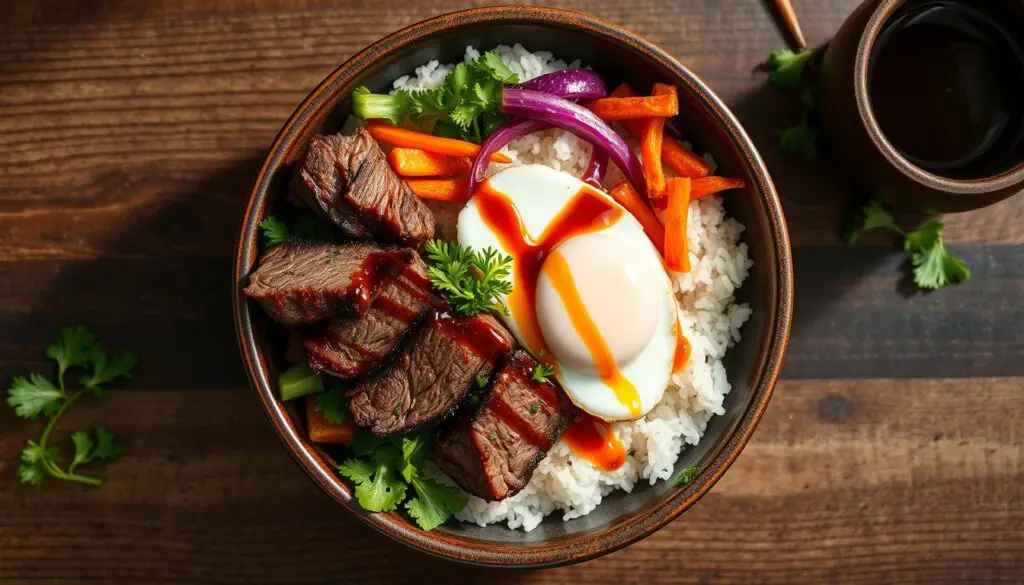
This BBQ Korean Steak Rice Bowl combines tender marinated beef with fresh vegetables and a spicy-sweet sauce for a restaurant-quality meal at home.
Prep Time
30 minutes (plus marinating)
Cook Time
15 minutes
Total Time
45 minutes (plus marinating)
Servings
4 servings
Ingredients
For the Korean BBQ Steak:
- 1 pound top sirloin steak, thinly sliced against the grain
- 1/3 cup soy sauce (low sodium recommended)
- 3 tablespoons brown sugar
- 2 tablespoons sesame oil
- 1 tablespoon gochujang (Korean chili paste)
- 4 cloves garlic, minced
- 1 tablespoon fresh ginger, grated
- 1/2 Asian pear, grated (or substitute with a regular pear or apple)
- 2 tablespoons green onions, chopped
For the Rice Bowl:
- 2 cups cooked white rice (short-grain preferred)
- 1 cup spinach or mixed greens
- 1 carrot, julienned or spiralized
- 1 bell pepper (red or yellow), thinly sliced
- 1/2 cucumber, thinly sliced
- 2 green onions, sliced diagonally
- 4 eggs (optional, for topping)
- Kimchi for serving (optional)
- 1 tablespoon sesame seeds, for garnish
For the Sauce:
- 2 tablespoons gochujang
- 1 tablespoon honey or maple syrup
- 1 tablespoon sesame oil
- 1 tablespoon rice vinegar
- 1 tablespoon water (to thin)
- 1 teaspoon sesame seeds
Instructions
- Prepare the steak: Slice the steak thinly against the grain. Place in a large bowl or resealable plastic bag.
- Make the marinade: In a food processor, combine garlic, ginger, and Asian pear. Pulse until smooth. Transfer to a bowl and add soy sauce, brown sugar, sesame oil, gochujang, and green onions. Mix well.
- Marinate the steak: Pour the marinade over the steak and ensure all pieces are coated. Refrigerate for at least 1 hour, preferably 4 hours or overnight.
- Prepare the sauce: In a small bowl, whisk together gochujang, honey, sesame oil, rice vinegar, water, and sesame seeds. Set aside.
- Cook the steak: Heat a large skillet over high heat. Working in batches, cook the marinated steak for 1-2 minutes per side until caramelized and cooked through. Transfer to a plate.
- Cook eggs (if using): In the same pan, fry eggs to your preferred doneness.
- Assemble the bowls: Divide rice among four bowls. Arrange steak, vegetables, and kimchi (if using) around the rice. Top with a fried egg if desired.
- Finish and serve: Drizzle with the prepared sauce, sprinkle with sesame seeds and green onions, and serve immediately.
Notes
- For easier slicing, place the steak in the freezer for 30 minutes before cutting.
- The steak can be marinated for up to 24 hours for maximum flavor.
- For a low-carb option, substitute cauliflower rice for white rice.
- Vegetarian option: Replace steak with extra-firm tofu, pressed and sliced.
Enjoy Your Homemade BBQ Korean Steak Rice Bowl!
Creating restaurant-quality BBQ Korean Steak Rice Bowls at home is not only possible but surprisingly simple. With the right ingredients and techniques, you can enjoy this flavorful, balanced meal any day of the week. The combination of tender marinated steak, fresh vegetables, and that irresistible sweet-spicy sauce creates a dish that's sure to become a favorite in your recipe collection.
Whether you're new to Korean cuisine or a seasoned enthusiast, this recipe offers a perfect entry point to explore the delicious world of Korean flavors. Don't be afraid to experiment with different vegetables, proteins, or spice levels to make this dish your own. And remember, the key to authentic Korean BBQ is in the marinade and that perfect caramelization that comes from cooking at high heat.
We'd love to hear how your BBQ Korean Steak Rice Bowl turns out! Share your creations and let us know any variations you tried in the comments below.
Ready to Try More Asian-Inspired Recipes?
Explore our collection of delicious Asian recipes from Korean, Japanese, Chinese, and Thai cuisines!

